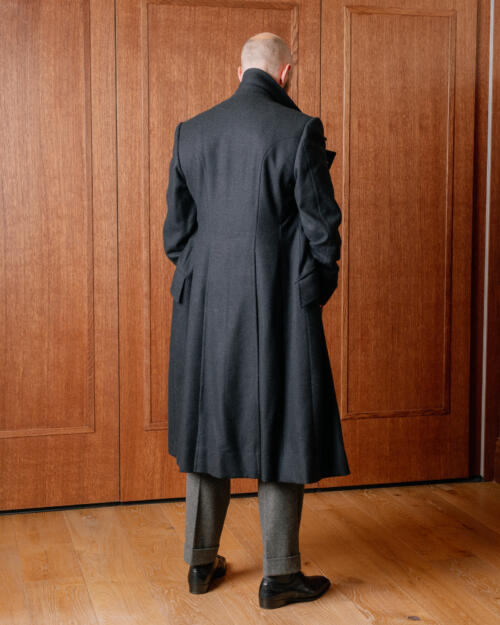
This great coat from Edward Sexton is probably the most unusual model in this series, which has been looking at the styles of my various bespoke coats, in particular how they are cut and made.
Sexton coats tend to have a bit of drama to them anyway, as with the rest of the tailoring. But when you combine that with a great coat’s long collar and big lapels – all necessitated by the big, ten-button wrap – you get something particularly dramatic.
I talked about why I commissioned the coat originally, and how I’ve come to wear it over the years, in this Great Things post. I won’t go into more detail here.
I’ll simply say that it’s not a coat I wear often, but that I really appreciate when I do. I wouldn’t encourage anyone to have it as their first bespoke, but if they love the work that goes into making something like this, and can find a way to wear it naturally – as part of their own, very personal style – it really is wonderful.
Today, the main focus will be that tailoring work that often gets hidden behind the drama.
House: Edward Sexton
Address: 35 Savile Row, London
Site: www.edwardsexton.co.uk
Cutter: Edward Sexton
Price (at time of writing): £7,500 (incl VAT)
Price of a two-piece suit: £6,600
In order for a great coat to button right up across the top of the chest, it requires wide lapels that fold down dramatically when they’re not closed.
This fastening can be designed in a less dramatic way if there is a smaller wrap (the overlapping of the two sides) as with a traditional trench coat. But if anything a great coat goes in the opposite direction, maximising the amount of chest that is covered by two layers of material.
This was originally practical, to provide the greatest protection to soldiers that wore them. But over time the size of that wrap, and the curved shape the lapel creates as it runs around the edge of the chest, have become intrinsically linked with a whole set of military clothing, regardless of the practical advantages.
This big wrap makes the coat very warm, and I find the most practical way to wear it is often with the right-hand side buttoned up at the collar bone, but the left side left open – as shown in the image below from that Great Things post.
This means there is only one layer of cloth across the chest, and it makes it a lot quicker to undo when you come to take it off.
However from a tailoring point of view – as with most coats in this series – the back is actually more interesting than the front.
The drama here comes from the combination of the length, the roped shoulders, and those two curved seams running from the sleeves into the waist.
The seams are something you get on formalwear such as a morning coat (covered in a series here) but a morning coat also has a central seam in the centre of the back, plus some kind of cut across the waist. This has neither. So there’s a huge uninterrupted back, with the two curving seams running all the way down to the hem. It’s a stunning bit of tailoring.
I did have some issues with this design from a practical point of view, with the two pleats in the lower half opening rather easily. But Edward tacked down the first three inches or so, and that solved the problem.
Other interesting tailoring points are that those two curving seams perfectly meet the seams of the sleeves. It would look a little off if they didn’t, but still it’s nice.
The collar and collar stand are also one piece, rather than two; and the large slanting pockets echo the angles and scale of the lapels.
“It’s such a nicely put together piece – something where all the elements work together,” commented one tailor I talked to. “You can imagine previous iterations having different pockets, or a different button placement, and now this one feels like the perfected version, reached after time and experimentation.”
I remember talking to Edward, who sadly passed away last year, about the design at the time. He mentioned his idea of the design had changed, including the way the back was put together.
“You can’t help feeling that it takes a tailor of a certain experience to make something like this, which feels distinctive yet perfected. That’s rarely the case when you see younger tailors’ designs,” the tailor continued. “Let’s hope there are other people doing this now that Edward has gone.”
The cloth used is a mix of Lumb’s Golden Bale wool and cashmere (85/15 split) – Harrison’s overcoating bunch, code 83924.
I had a question recently from a reader about it, and whether it would make a good choice for a business coat. I think it would: the Golden Bale wool is always lovely and that fine merino combined with the cashmere makes it warm for a 21oz weight.
The only caveat would be that the cloth has a little sheen, being such a fine merino, and I would only use it for a smart business coat. The luxurious feel and smooth finish would make it less appropriate for a coat that someone wanted to wear casually as well, such as my recent B&Tailor.
Style breakdown
- Shoulder width: 6¾ inches
- Shoulder padding: Thin at the neck, thick at the sleevehead
- Sleevehead: Quite tall
- Lapel width: 7½ inches
- Collar width (at gorge): 4½ inches
- Gorge height: 6 inches
- Outbreast pocket height: n/a
- Buttoning point: 21 inches
- Wrap: 4¾ inches
- Back length: 48½ inches
Other clothes shown:
- Lilac-and-white striped shirt, D’Avino
- Grey woollen tie, Ralph Lauren
- Mid-grey flannel trousers from Whitcomb & Shaftesbury
- Black-calf ‘imitation brogues’, bespoke from Cleverley


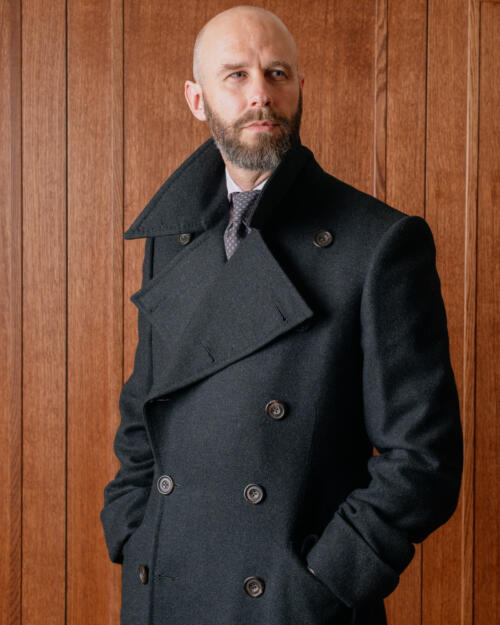
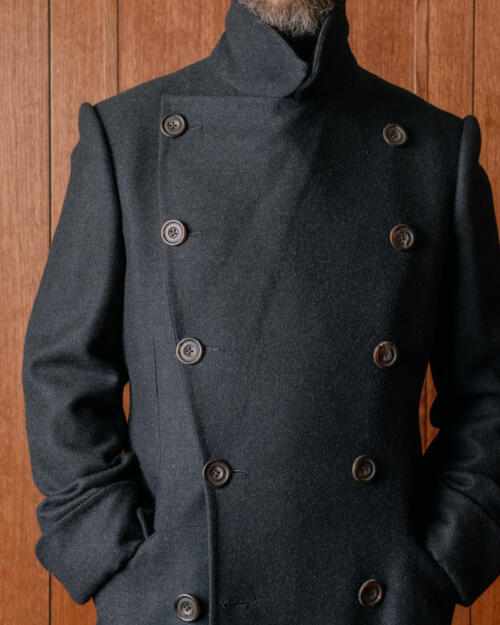
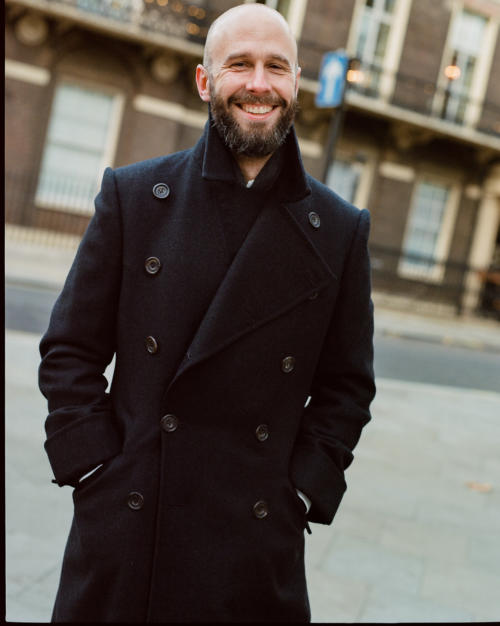
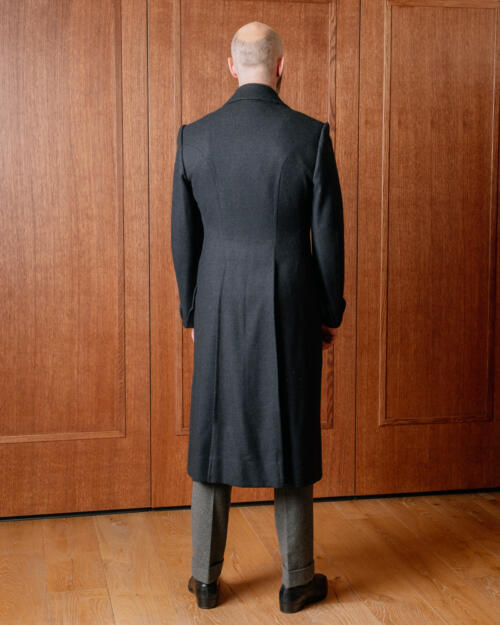
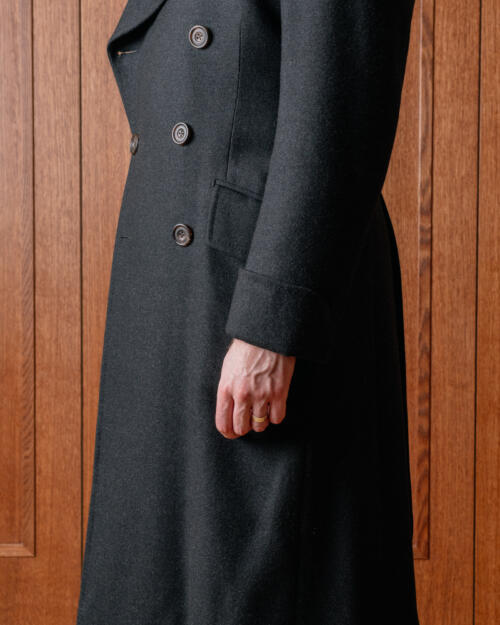
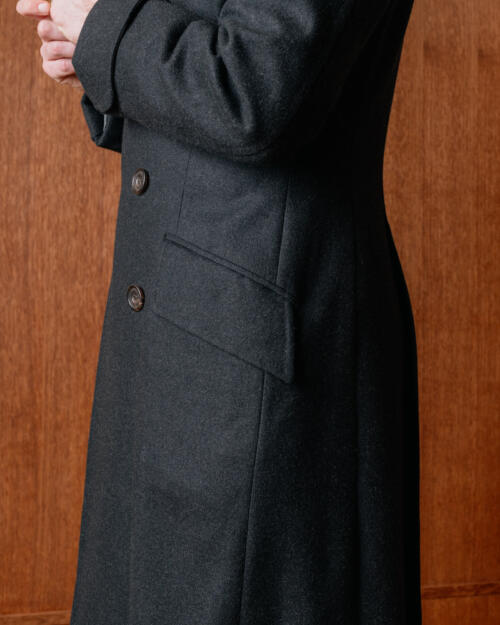
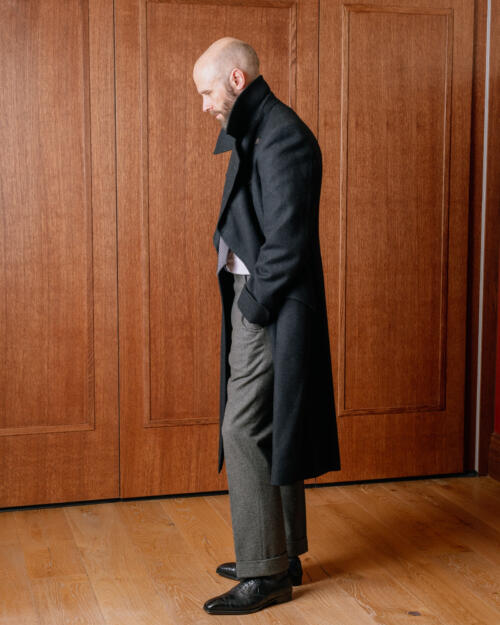


























That coat, as you say, may be the most unusual in the series but doesn’t detract from the magnificence of the Master’s hand.
Edward will be missed and I sincerely hope that these great talents are passed safely to new and capable hands.
Hi Simon,
An amazing piece. In my opinion it sits on that blurred line between artisanal craft and art. Whilst not for me, it’s something to be admired. I can almost see it accompanied by a silver top cane – which I don’t in any way mean sarcastically.
On a different note, a pleasure to meet you in the pop up yesterday and the opportunity to try on your Grey Donegal Coat (albeit in a size or so too big). Good thought on perhaps sizing up to give it a more wrap around feel. A coat that is for me! Have requested my addition to the waiting list for (I think?) October.
All the best
It was lovely to see you Stephen, thank you for coming in. Yes I think sizing up would be good, and yes we’ll have some more in September
I think this a really interesting comment – stylistically it does look closer to something by Paul Harnden or Elena Dawson, so I wonder if this might be an area worth exploring. I’m not suggestion Simon go full-on Carol Christian Poell (although…) but the connections between bespoke and artisanal clothing could be worth investigating. Of course – and as some commentators have already noted – there is the risk of things becoming too costume-y, but I’d still be interested to hear your thoughts on this.
great article as always! For me personally it is the least appealing coat from the serie. I think its the collar and the buttons which get so strong in one viewers eye and reminds me of a casual factor like a peacoat, but the overall smartness factor don’t plays well with it – just my points, I can easily imagine how it can look good for others – nevertheless keep up the good work you are doing!
Cheers Max
It’s a shame as I don’t doubt the make being second to none, but every time I’ve seen this coat, my gut reaction has always been “what a ridiculous item of clothing.” Looks more like it belongs in the costume department of a Tim Burton film than on anyone in real life.
Can’t think of any set of circumstances where wearing it would seem appropriate.
It’s an amazing coat – a bit polarizing, judging by the comments, but part of the appeal of Sexton is the fact that it’s not for everyone. It’s bold. It has drama. Swagger, even.
Speaking of Sexton, I know you have recommended against the RTW greatcoats from them (I guess it’s a “them” now, not a “him”). Is this because the quality isn’t up to spec (for the price), or because the cut is just too unusual for it to be appropriate for most people? Having a fairly good selection of coats already, I love the drama of the Sexton coats, but their prices is out of my range, especially since it would be an only commission and bespoke really shines when you invest time and money in the relationship, nailing down the fit over several orders. But a RTW coat would be a possibility from that perspective.
I haven’t tried them for a while actually Sam, but I think it was because the fit is so integral for me to why it looks good, I’d be afraid that without that aspect it would take away the beautiful-object side of it
That’s a good point. I will likely be in London this spring, maybe if I mail them they can have one in my size ready to try on. If I size up, I’m sure my tailor could do some alterations. And as it has been said before, coats are always going to be a compromise on fit, since you might want to wear them with a structured jacket, or a soft knit.
Still, I tried to ask their customer support about if there was room to let their coats out if needed, and the response I got was “The measurements is in the size guidelines”, but hopefully they’re more knowledgable in person.
Yes, I think that sounds like a good plan Sam
A related thought; I’ve been looking at cashmere blends for a navy coat (I know I’ve ranted a lot about cashmere coats, I just can’t let it go :)), and the one you used for this coat has been on my radar (as well as a 20Oz 50% cashmere blend from Harrissons). But as you point out, many cashmere blends become fairly dressy. How would you say the fabric used in this coat compares to the one used in the PS Bridge Coat? The Bridge Coat is one of my favourites for more casual tailoring outfits (flannels and cashmere knits), and it is 20% cashmere. Is the mix you used for your greatcoat significantly dressier?
And completely unrelated: is RL making a jacket using the PS Plaid from JE? It looks VERY similar. https://www.ralphlauren.eu/se/en/kent-handmade-plaid-cashmere-jacket-655378.html?webcat=content%20men%20purple%20label%20all#prefn1=CategoryCode&prefv1=Blazers&webcat=content-men-purple-label-all&allRefinementsRemoved=true&start=1&cgid=men-purple-label-all
Yes, I would say it’s significantly dressier – the merino is finer and it shows.
Yeah I saw that. They use JE so I wouldn’t be surprised if it’s similar
Dear Sam,
I recently commissioned a greatcoat in 30% Cashmere 70% woolblend 21oz Loro Piana cloth.
Granted it’s only been a few weeks, and I love the coat and the cloth, but I think if I were to make another coat, I’d much prefer something made in 100% wool-its just more structured and hardy, which is particularly relevant if you wear it with the collar up. I do have a Frank Leder greatcoat made in wool for reference.
I must say I wear it over knitwear and almost never a suit, so Ymmv.
Thanks, and interesting to hear.
Yes the Frank Leder materials are pretty tough!
I do love when customer services don’t actually answer the question but instead respond with some version of “go read the provided material which does not in fact contain the answer to the question you asked”.
I’m wondering if it was actually a chat-bot rather than an actual person. It was before the AI boom, which might explain why the answer was so inane.
You should try the RTW version in person front is proper dramatic but back on the RTW has a lot more pleats instead of clean back (I suspect easier to get the fit right)
To have such a piece tailored by the great man himself is a rare privilege indeed!
A really impressive garment! Though, with ordinary flannels and oxfords and a tie it seems kind of overwhelming. I think a more aggressive outfit might be needed to match the drama.
Yes, interesting point AK. If that style were me I’d definitely try it
Hi Simon – great to meet you, and Manish, at the popup the other day.
I’m fairly certain that, if I could afford it / justify the expense, I’d be beating a path to 35 Savile Row on Monday morning – even though I don’t know when I would wear such a coat. It’s a beautiful thing! In its earlier incarnation, before it was shortened, it was essentially costume. Now? I think it’s a spectacular statement piece, but no longer with that theatrical overtone. I was actually rather sad to read that you had had it shortened, but I quite understand why! In many ways I think its visual simplicity is key – there seems to be little ornament, but what is there is so elegantly constructed. Those seams running up the back to meet the seams on the arms, the sweep of the huge lapels – the work of a master. And the confidence needed to leave it just so, without cluttering it further – priceless.
In an earlier stage of life, I collected a particular brand of sunglasses, and amassed a significant collection – more than 70 pieces. I still have them and, like your Sexton Greatcoat among all your other coats, there are some much-loved members of the collection which only come out to play a few times a year. In some cases it’s because of rarity, value, or the impossibility of e.g. replacing a lens in a long-discontinued model should they get scratched. But for some, they are so dramatic, so much of a statement, that there are only a limited number of occasions when I feel they are appropriate. The Greatcoat seems to me similar; but when such pieces do see the light of day, I have no doubt that this gorgeous piece of tailoring, like my sunglasses for me, fills you with joy.
Hi Simon, this is an excellent piece of writing and a stunning coat no less. It got me thinking. I’ve recently been trying to track down a good, serviceable charcoal grey overcoat for lighter flannels that struggle to pair with navy. A few years back there would have been some obvious stalwart solutions (Crombie, New & Lingwood, G&H) but it seems that nowadays it’s a real struggle. Do you have any recommendations?
I don’t have any specific recommendations I’m afraid, just because it’s not something I look at that much. But I would look first at the shops Manish talks about here to see if they have anything like that
Thanks Simon, will do.
I do like the thought of “amortizing” any piece of clothing I’ve bought — even in the abstract.
That you rarely wear it, makes me think it’s more costume than utility: the kind of thing you wear when you want to feel like a side character in Peaky Blinders.
That Sexton made it makes me think — wonderful — but then (perhaps) it belongs in a fashion school’s museum, on a mannequin, or at The British Museum on display.
And if I didn’t have a delightful pop-up to pop-into as I went about my afternoon signing books, where the proprietor could safely store my $9,500 USD coat (and had the room to store such a long garment), then where would I conceivably put it and not worry about it?
Would I wear it inside the pub? An art gallery? Would I dare leave it at coat-check?
I think about the $50,000 vicuna coat that was commissioned in Australia, and chronicled in great detail in the book “The Coat Route” (by Meg N.L.).
That vicuna coat seemed wholly useful — something for daily wear (well, not in Australia, but I’m guessing the owner of it travels a lot for business). A classic, single breasted navy vicuna coat is a staple.
And I know this “great coat” is no “staple” — but what about the notion of essential? If we should choose things that are “permanent” (in terms of style), then why feature something (and commission something) so dated, something ripped (or sheared) from a period piece serial (as I mentioned), or something one would likely find documented in vintage photos, and not (often) in modern London (to this extreme, anyway)?
And if it’s not what you’d suggest any reader get for their “first commission,” then why should this over-the-top piece take up space in anyone’s closet if it’s not really in your “rotation” at all, especially if it creates a kind of burden for the wearer outside of his closet as well?
I go back to the ethos of this website when it began (and stated) so many years ago, and I think how sharply it contrasted to most of the static ideology elsewhere: it wasn’t about “keep expanding your wardrobe,” “keep buying,” “have things you don’t really use,” — it seemed to be more like: “If I could only have 5 coats, 5 trousers, 5 suits.” And I saw that become a kind of mixed-message as the years went on: you still had those features about “If I could only have…” but then you had more of these kinds of breakdowns of coats you were more likely to give away, rarely wear, or regret having commissioned in the first place.
For me:
With (to some degree) a limited budget to spend on clothes specifically, I think – increasingly – about the simplest of notions:
How can I justify the garment hanging in my closet without lying to myself to keep it, or making similar mistakes moving forward?
As is my wont, I will chime in on the Overcoat Series. I’m happy to see this coat make an appearance!
Also, for some reason I feel the need to comment and engage with the site in a more abstract/conceptual way so I apologize for that.
I recall the original post when you acquired this coat. It was and remains an extremely compelling and dramatic piece. I’m curious how it worked as an “investment” for the site as an attention-getter – while that was probably far down the list of reasons for commissioning it, it probably didn’t hurt! And of course now you essentially have a piece of art from a renowned artist who is no longer with us, along with personal cherished memories. So from that perspective, however impractical it may be to wear day-to-day, you have something special to treasure. I could see this coat ending up in a museum exhibit someday.
More along those lines, and as noted by yourself and others, the flipside to having “wearable art” is that this is another example of the potential pitfalls of style vs. costume, which is helpful for readers. It allows one to thoughtfully engage with and admire specific concepts and design/style points and decide if they are worth pursuing in one’s own wardrobe. To your credit you have often warned of the more costume-like trappings in which enthusiasts can sometimes get caught up.
This brings me to my other thought, again about the evolution of this site and your own personal style journey that you are publicly chronicalling – and the similar journeys of many readers, I’m sure. There’s probably a chart for this somewhere (it’s not an original thought) showing how as one gets into a hobby/interest, one starts out knowing little, then learning more and thus desiring many very specific things, and then later settling into personal taste. This coat would have been very high on the “desire” list at one point – for all the reasons above – but I totally see how it’s mostly impractical for most people and situations. There’s a constant battle between the “wanting the object” and the actual necessity or practical use one would get out of it!
As the focus of this site (and what’s left of menswear blogs in general) has somewhat changed alongside society’s changes – from wanting (or being expected) to wear 5 suits a week to whatever we have now – it’s interesting and instructive to look back to see how something considered “timeless” really was or wasn’t.
Much of the above is rehashing similar points made elsewhere but I thought it was worth raising them here. As always, thank you for providing the opportunity to ruminate about such things.
I love this coat for the sheer sense of drama it engenders. I fear, however, that someone of my 5’8” would be swamped by its length and copious enfolding. Would you agree that you probably need more height to successfully wear this kind of coat, Simon? I do like the Edward Sexton topcoats – do you think they would give some of the effect of this coat for those who are somewhat vertically challenged?
I think you might be right on the length, yes. The top coats are nice too but different, more formal. I’m not sure it would be that much of the same effect
I seem to remember the coat looking a bit longer when first commissioned – did you have it shortened?
Yes I did
Hi Simon, a completely different topic: Your pink and blue/white wristband. Do you leave it on your arm the whole time or does it have a fast mechanism to change the size, so you can easily put it off change it? Is it pure cotton or a blend?
I really like the style/combination of it 🙂 Would even highly appreciate a own post about it maybe sometime 🙂
Hey Max,
They’re just friendship bracelets made for me by my children. No idea what they’re made of I’m afraid. And yes they have to stay on the whole time!
Thank you for your response Simon! Maybe you are doing some near photos of them, so the reader could detect how they are made? There are tons of different friendship bracelet techniques and yours look really nice! I searched for string bracelet but could not find one bracelet that looks like the technique used in yours 🙂
Kind regards Max
Sure Max. I think it’s basically just a plait, and you can vary how thick that is
You get very familiar with plaits when you have girls!
Hi Simon_Always loved this coat!
I see you had it altered. It looks great on you based on the images in the piece. Just curious what you had adjusted. Thanks
A little while after buying it, I had it shortened, just because it was so very long to start with. But that’s it, other than letting it out a little bit more recently
Clearly, very high quality. Even a neophyte can see that. In terms of versatility, it’s fairly limited in that respect. Another reader said it’s venturing into costume territory, which it seems to be doing.
Very Sherlock Holmes. But the artistry and work put into the coat must be appreciated.
Yes, I can see why some would say it’s a bit dramatic for them (or “costumey”, depending on your taste), but I’ve never seen a great coat that isn’t.
Honestly, this is one of the most elegant interpretations I’ve seen. It feels modern, but it’s pretty subtle, not forced.
I certainly don’t think anyone would look twice at you in a crowd, except to say that it’s a nice coat!
This is a spectacular coat. The fact that it’s made by Edward Sexton makes it special. There won’t be any more. Sure, the coat is a wild card, but so what? You can wear a more standard overcoat on another day. An unusual piece does not need to be worn all the time for it to be worth it.
I have an RTW great coat from Edward Sexton (black calvary twill version). Easily my favorite piece of garment in my entire wardrobe. I purchased it because I don’t have the time nor budget to go bespoke in London, simply too far away from me. I’d recommend to give Sexton RTW a try if you like the style. The make and cloth quality is superb in my opinion, and no one can resist the swag.